The 2020 Mac Mini Unleashed: Putting Apple Silicon M1 To The Test
by Andrei Frumusanu on November 17, 2020 9:00 AM ESTSection by Ryan Smith
M1 GPU Performance: Integrated King, Discrete Rival
While the bulk of the focus from the switch to Apple’s chips is on the CPU cores, and for good reason – changing the underlying CPU architecture if your computers is no trivial matter – the GPU aspects of the M1 are not to be ignored. Like their CPU cores, Apple has been developing their own GPU technology for a number of years now, and with the shift to Apple Silicon, those GPU designs are coming to the Mac for the very first time. And from a performance standpoint, it’s arguably an even bigger deal than Apple’s CPU.
Apple, of course, has long held a reputation for demanding better GPU performance than the average PC OEM. Whereas many of Intel’s partners were happy to ship systems with Intel UHD graphics and other baseline solutions even in some of their 15-inch laptops, Apple opted to ship a discrete GPU in their 15-inch MacBook Pro. And when they couldn’t fit a dGPU in the 13-inch model, they instead used Intel’s premium Iris GPU configurations with larger GPUs and an on-chip eDRAM cache, becoming one of the only regular customers for those more powerful chips.
So it’s been clear for some time now that Apple has long-wanted better GPU performance than what Intel offers by default. By switching to their own silicon, Apple finally gets to put their money where their mouth is, so to speak, by building a laptop SoC with all the GPU performance they’ve ever wanted.
Meanwhile, unlike the CPU side of this transition to Apple Silicon, the higher-level nature of graphics programming means that Apple isn’t nearly as reliant on devs to immediately prepare universal applications to take advantage of Apple’s GPU. To be sure, native CPU code is still going to produce better results since a workload that’s purely GPU-limited is almost unheard of, but the fact that existing Metal (and even OpenGL) code can be run on top of Apple’s GPU today means that it immediately benefits all games and other GPU-bound workloads.
As for the M1 SoC’s GPU, unsurprisingly it looks a lot like the GPU from the A14. Apple will have needed to tweak their design a bit to account for Mac sensibilities (e.g. various GPU texture and surface formats), but by and large the difference is abstracted away at the API level. Overall, with M1 being A14-but-bigger, Apple has scaled up their 4 core GPU design from that SoC to 8 cores for the M1. Unfortunately we have even less insight into GPU clockspeeds than we do CPU clockspeeds, so it’s not clear if Apple has increased those at all; but I would be a bit surprised if the GPU clocks haven’t at least gone up a small amount. Overall, A14’s 4 core GPU design was already quite potent by smartphone standards, so an 8 core design is even more so. M1’s integrated GPU isn’t just designed to outpace AMD and Intel’s integrated GPUs, but it’s designed to chase after discrete GPUs as well.
| A Educated Guess At Apple GPU Specifications | |||
| M1 | |||
| ALUs | 1024 (128 EUs/8 Cores) |
||
| Texture Units | 64 | ||
| ROPs | 32 | ||
| Peak Clock | 1278MHz | ||
| Throughput (FP32) | 2.6 TFLOPS | ||
| Memory Clock | LPDDR4X-4266 | ||
| Memory Bus Width | 128-bit (IMC) |
||
Finally, it should be noted that Apple is shipping two different GPU configurations for the M1. The Mac Mini and MacBook Pro get chips with all 8 GPU cores enabled. Meanwhile for the Macbook Air, it depends on the SKU: the entry-level model gets a 7-core configuration, while the higher-tier model gets 8 cores. This means the entry-level Air gets the weakest GPU on paper – trailing a full M1 by around 12% – but it will be interesting to see how the shut-off core influences thermal throttling on that passively-cooled laptop.
Kicking off our look at GPU performance, let’s start with GFXBench 5.0. This is one of our regular benchmarks for laptop reviews as well, so it gives us a good opportunity to compare the M1-based Mac Mini to a variety of other CPU/GPU combinations inside and outside the Mac ecosystem. Overall this isn’t an entirely fair test since the Mac Mini is a small desktop rather than a laptop, but as M1 is a laptop-focused chip, this at least gives us an idea of how M1 performs when it gets to put its best foot forward.
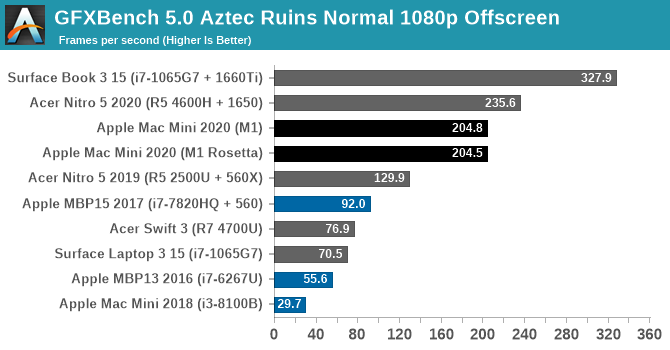
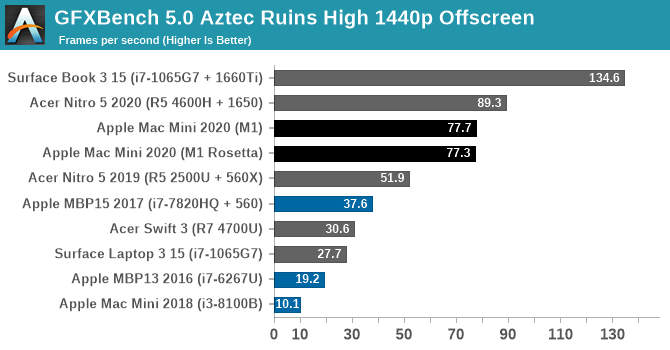
Overall, the M1’s GPU starts off very strong here. At both Normal and High settings it’s well ahead of any other integrated GPU, and even a discrete Radeon RX 560X. Only once we get to NVIDIA’s GTX 1650 and better does the M1 finally run out of gas.
The difference compared to the 2018 Intel Mac Mini is especially night-and-day. The Intel UHD graphics (Gen 9.5) GPU in that system is vastly outclassed to the point of near-absurdity, delivering a performance gain over 6x. And even other configurations such as the 13-inch MBP with Iris graphics, or a PC with a Ryzen 4700U (Vega 7 graphics) are all handily surpassed. In short, the M1 in the new Mac Mini is delivering discrete GPU-levels of performance.
As an aside, I also took the liberty of running the x86 version of the benchmark through Rosetta, in order to take a look at the performance penalty. In GFXBench Aztec Ruins, at least, there is none. GPU performance is all but identical with both the native binary and with binary translation.
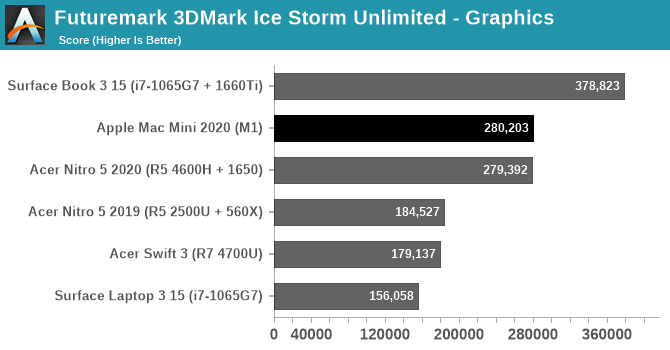
Taking one last quick look at the wider field with an utterly silly synthetic benchmark, we have 3DMark Ice Storm Unlimited. Thanks to the ability for Apple Silicon Macs to run iPhone/iPad applications, we’re able to run this benchmark on a Mac for the first time by running the iOS version. This is a very old benchmark, built for the OpenGL ES 2.0 era, but it’s interesting that it fares even better than GFXBench. The Mac Mini performs just well enough to slide past a GTX 1650 equipped laptop here, and while this won’t be a regular occurrence, it goes to show just how potent M1 can be.
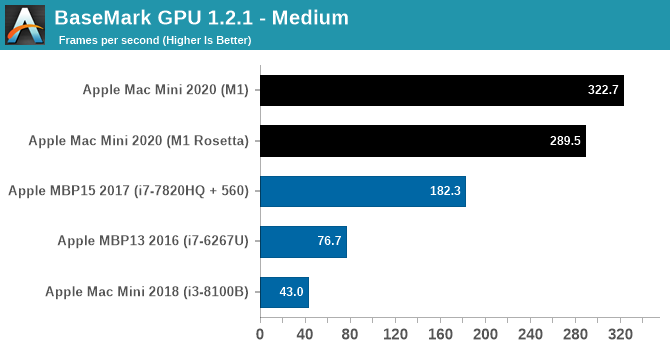

Another GPU benchmark that’s been updated for the launch of Apple’s new Macs is BaseMark GPU. This isn’t a regular benchmark for us, so we don’t have scores for other, non-Mac laptops on hand, but it gives us another look at how M1 compares to other Mac GPU offerings. The 2020 Mac Mini still leaves the 2018 Intel-based Mac Mini in the dust, and for that matter it’s at least 50% faster than the 2017 MacBook Pro with a Radeon Pro 560 as well. Newer MacBook Pros will do better, of course, but keep in mind that this is an integrated GPU with the entire chip drawing less power than just a MacBook Pro’s CPU, never mind the discrete GPU.
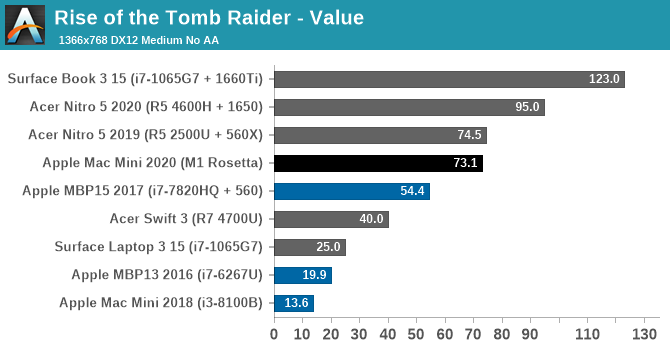
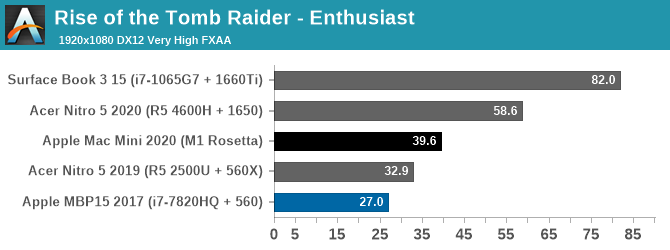
Finally, putting theory to practice, we have Rise of the Tomb Raider. Released in 2016, this game has a proper Mac port and a built-in benchmark, allowing us to look at the M1 in a gaming scenario and compare it to some other Windows laptops. This game is admittedly slightly older, but its performance requirements are a good match for the kind of performance the M1 is designed to offer. Finally, it should be noted that this is an x86 game – it hasn’t been ported over to Arm – so the CPU side of the game is running through Rosetta.
At our 768p Value settings, the Mac Mini is delivering well over 60fps here. Once again it’s vastly ahead of the 2018 Intel-based Mac Mini, as well as every other integrated GPU in this stack. Even the 15-inch MBP and its Radeon Pro 560 are still trailing the Mac Mini by over 25%, and it takes a Ryzen laptop with a Radeon 560X to finally pull even with the Mac Mini.
Meanwhile cranking things up to 1080p with Enthusiast settings finds that the M1-based Mac Mini is still delivering just shy of 40fps, and it’s now over 20% ahead of the aforementioned Ryzen + 560X system. This does leave the Mini well behind the GTX 1650 here – with Rosetta and general API inefficiencies likely playing a part – but it goes to show what it takes to beat Apple’s integrated GPU. At 39.6fps, the Mac Mini is quite playable at 1080p with good image quality settings, and it would be fairly easy to knock down either the resolution or image quality a bit to get that back above 60fps. All on an integrated GPU.
Update 11-17, 7pm: Since the publication of this article, we've been able to get access to the necessary tools to measure the power consumption of Apple's SoC at the package and core level. So I've gone back and captured power data for GFXBench Aztec Ruins at High, and Rise of the Tomb Raider at Enthusiast settings.
| Power Consumption - Mac Mini 2020 (M1) | ||||
| Rise of the Tomb Raider (Enthusiast) | GFXBench Aztec (High) |
|||
| Package Power | 16.5 Watts | 11.5 Watts | ||
| GPU Power | 7 Watts | 10 Watts | ||
| CPU Power | 7.5 Watts | 0.16 Watts | ||
| DRAM Power | 1.5 Watts | 0.75 Watts | ||
The two workloads are significantly different in what they're doing under the hood. Aztec is a synthetic test that's run offscreen in order to be as pure of a GPU test as possible. As a result it records the highest GPU power consumption – 10 Watts – but it also barely scratches the CPU cores virtually untouched (and for that matter other elements like the display controlller). Meanwhile Rise of the Tomb Raider is a workload from an actual game, and we can see that it's giving the entire SoC a workout. GPU power consumption hovers around 7 Watts, and while CPU power consumption is much more variable, it too tops out just a bit higher.
But regardless of the benchmark used, the end result is the same: the M1 SoC is delivering all of this performance at ultrabook-levels of power consumption. Delivering low-end discrete GPU performance in 10 Watts (or less) is a significant part of why M1 is so potent: it means Apple is able to give their small devices far more GPU horsepower than they (or PC OEMs) otherwise could.
Ultimately, these benchmarks are very solid proof that the M1’s integrated GPU is going to live up to Apple’s reputation for high-performing GPUs. The first Apple-built GPU for a Mac is significantly faster than any integrated GPU we’ve been able to get our hands on, and will no doubt set a new high bar for GPU performance in a laptop. Based on Apple’s own die shots, it’s clear that they spent a sizable portion of the M1’s die on the GPU and associated hardware, and the payoff is a GPU that can rival even low-end discrete GPUs. Given that the M1 is merely the baseline of things to come – Apple will need even more powerful GPUs for high-end laptops and their remaining desktops – it’s going to be very interesting to see what Apple and its developer ecosystem can do when the baseline GPU performance for even the cheapest Mac is this high.


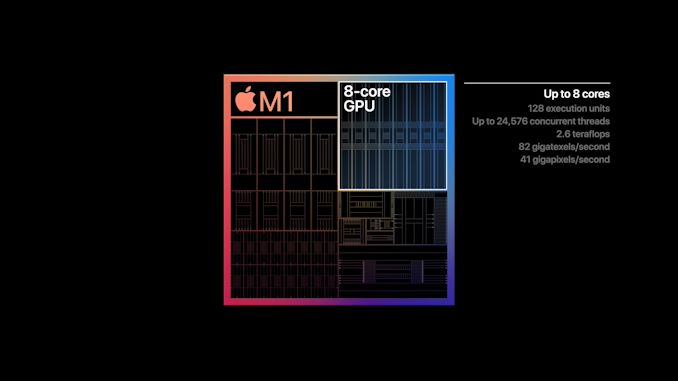








682 Comments
View All Comments
BushLin - Wednesday, November 18, 2020 - link
8-core mobile zen 2 chips have been available for nearly a year now. By the time you can buy that unannounced product you speculate about, it'll be competing against 5nm zen 4 and would still be a toss up in performance against 7nm zen 2.Spunjji - Thursday, November 19, 2020 - link
You're both wrong.Zen 4 is due out in at least a year's time, possibly 18 months. I'll eat my hat if Apple haven't released their higher-end chip with larger cores by then.
That said, there's no reason to assume its CPU performance will be significantly higher than AMD's mobile Zen 3 designs. GPU will be for sure, but you're locked to a platform without access to decent games so that will limit the appeal to a certain audience.
So it's not "game over" for Zen 3 - especially as they don't directly compete - but BushLin's completely wrong about how an 8-core variant of this would stack up to Zen 2 and 3.
BushLin - Thursday, November 19, 2020 - link
So a 15W 8-core zen 2 beats a 15W 4+4 core M1 in multithreaded, close to real world tests; but a mythical 25-30W 8+4 CPU using the same design which hasn't scaled well from the additional watts it uses over the A14 chip is going to definitely, defiantly and majestically beat all comers, including zen 3? We'll see but random guy on the internet is probably just pulling stuff out of their ass.Spunjji - Monday, November 23, 2020 - link
@BushLin - Please check what I said again: "there's no reason to assume [M1's] CPU performance will be significantly higher than AMD's mobile Zen 3 designs". So no, I don't think it's going to "definitely, defiantly and majestically beat all comers, including zen 3" and you're kind of an ass for straw-manning me like that. Please don't.You keep making false comparisons with TDP too. Zen 2 is 15W at base clocks, but most of the tests seen so far take place largely within its turbo window of ~30W. Zen 3 Cezanne on 7nm will be in the same ballpark. A theoretical (not "mythical") 8+4 design should provide very similar performance in a very similar TDP, with the performance edge likely going to AMD. That indicates than Zen 4 on 5nm should likely be a superior option for both perf/watt and absolute performance, but we just don't know that yet as, in your terms, Zen 4 is still "mythical".
But sure, equally-random guy on the internet. We'll see when we see.
BushLin - Monday, November 23, 2020 - link
Both the M1 and 4800U are drawing more that 15W depending on workload, both settling around 22-24W after initial boost.mdriftmeyer - Friday, November 20, 2020 - link
Zen 4 is out Nov 2021, announced Oct 2021. It's already known. Zen 4 is nearly complete in design back in September. What's coming with Zen 4 is the technologies of Xilinx --Neural Engine: Check, Machine Learning Accelerators: check, DSPs for focused A/D Convert Encode/Decode: Check.People the single biggest news of SV this year isn't ARM+Nvidia or Apple M1 series. It's Xilinx merging to become part of AMD.
The IP, 13k engineers and portfolio of best in breed products by Xilinx [run by former AMD] is massive.
And Apple nor Intel nor Nvidia saw this coming.
Zen 4 APU will be a 5w or less CPU, with specialized add-ons, a massive Infinity Fabric interconnect, RAM not constrained like Apple, 8, 12, 16 CPU cores in dual chiplets and RDNA 3.0 CU GPU.
Fall 2021 will be Zen 4 CPU, APU/RDNA 3.0 and RDNA 3.0 discrete GPUs with CDNA 2.0 M series Compute Processors expanding their footprint into HPC.
You'll see the Zen 4/CDNA 2.0 solutions on El Capitan Fall 2021/Spring 2022. Clearly, to win that $600 million contract AMD showed their plans 12 months ago.
From March 04, 2020 Press Release
AMD technology within El Capitan includes:
Next generation AMD EPYC processors, codenamed “Genoa” featuring the “Zen 4” processor core. These processors will support next generation memory and I/O sub systems for AI and HPC workloads,
Next generation Radeon Instinct GPUs based on a new compute-optimized architecture for workloads including HPC and AI. These GPUs will use the next- generation high bandwidth memory and are designed for optimum deep learning performance,
The 3rd Gen AMD Infinity Architecture, which will provide a high-bandwidth, low latency connection between the four Radeon Instinct GPUs and one AMD EPYC CPU included in each node of El Capitan. As well, the 3rd Gen AMD Infinity Architecture includes unified memory across the CPU and GPU, easing programmer access to accelerated computing,
An enhanced version of the open source ROCm heterogenous programming environment, being developed to tap into the combined performance of AMD CPUs and GPUs, unlocking maximum performance.
“This unprecedented computing capability, powered by advanced CPU and GPU technology from AMD, will sustain America’s position on the global stage in high performance computing and provide an observable example of the commitment of the country to maintaining an unparalleled nuclear deterrent,” said LLNL Lab Director Bill Goldstein. “Today’s news provides a prime example of how government and industry can work together for the benefit of the entire nation.”
Note the emphasis on Genoa Zen 4 processor core, not Genoa Zen 4 CPUs.
Spunjji - Monday, November 23, 2020 - link
@mrdriftmeyer - do you have a source for the 2021 claim? The last roadmap I'm aware of had a Zen 3 refresh on desktop in 2021 (likely on AM5) followed by Zen 4 some time in 2022.Seeing as the rest of your post appears to consist mostly of wild speculation and unsupportable assertions (e.g. the Zen 4 design is already locked in, it's NOT going to contain Xilinx IP) I'm not going to hold my breath.
tempestglen - Tuesday, November 17, 2020 - link
BTW, M1 is a SoC, so please add GPU and RAM power of Zen3 during comparison.RedGreenBlue - Tuesday, November 17, 2020 - link
Benchmarks are benchmarks. I love AMD but in the power envelope the M1 is better. Also consider that this chip maxes out at 3.2Ghz not 4+. It’s just simply that x86-64 is a hinderance to AMD and Intel. That’s the real reason Apple had to switch and knew it with Steve Jobs in 2011. Intel is supposedly working on an x86 replacement. Haven’t heard anything new about it in years. But if they’re still working on it, it was expected in 2020-2022.RedGreenBlue - Tuesday, November 17, 2020 - link
This will also vastly improve their slim profit margins on macs too. Intel was charging such ridiculous prices for mediocre chips it was unbelievable. This is the best business model.